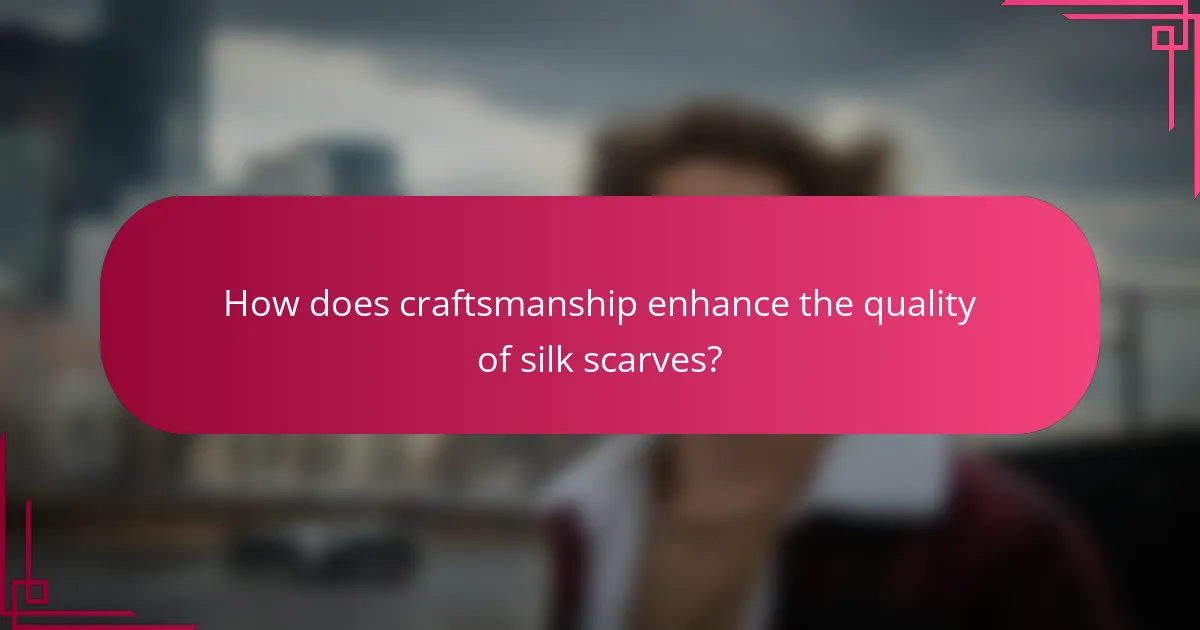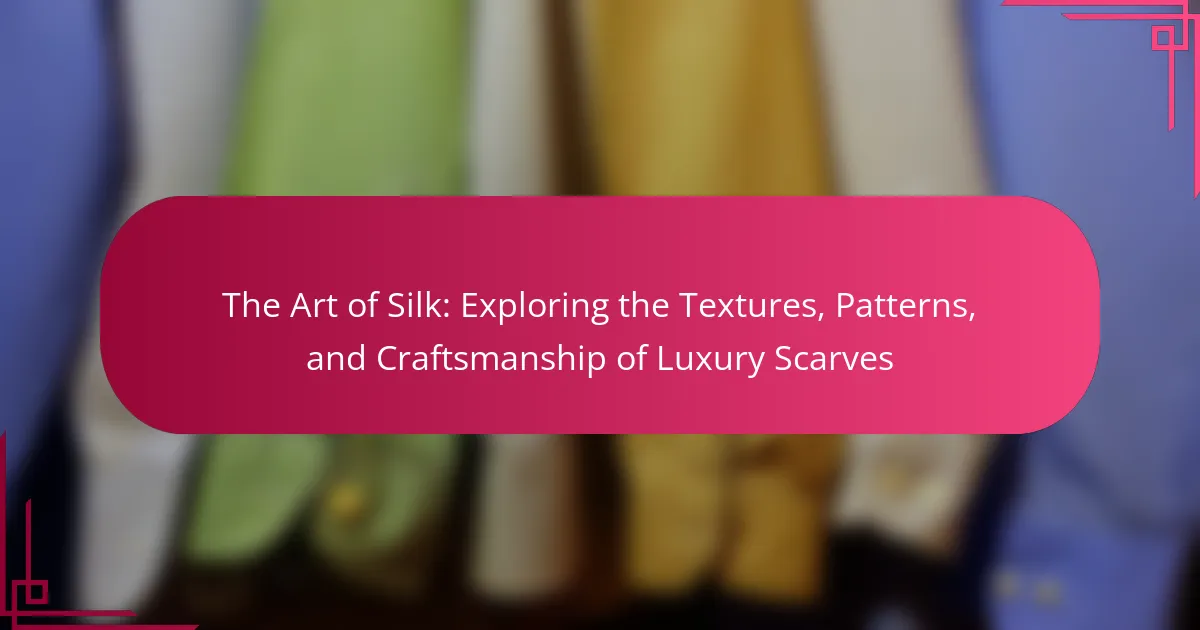Silk is a natural fiber prized for its luxurious texture, sheen, and softness, making it a preferred material for high-end scarves. The article explores the significance of silk in luxury fashion, highlighting its historical associations with wealth and the labor-intensive production process that contributes to its exclusivity. It also examines the craftsmanship involved in creating silk scarves, including precise weaving techniques, careful dyeing processes, and elegant finishing touches that enhance quality and durability. Additionally, the article provides practical care tips to maintain the scarf’s texture and color over time, ensuring it remains a valuable investment.

What is the significance of silk in luxury scarves?
Silk is significant in luxury scarves due to its luxurious texture and sheen. This natural fiber is known for its softness and smoothness, making it comfortable to wear. Silk also drapes elegantly, enhancing the overall aesthetic of the scarf. Its ability to retain vibrant colors allows for intricate designs and patterns. Historically, silk has been associated with wealth and status, adding to its appeal in luxury fashion. The production of silk is labor-intensive, contributing to its exclusivity. High-quality silk scarves can last for many years, making them a valuable investment.
How is silk produced and processed for scarf making?
Silk is produced from the cocoons of silkworms, primarily the Bombyx mori species. The process begins with the cultivation of mulberry trees, which serve as food for the silkworms. After about 25 to 30 days, the silkworms spin their cocoons using a continuous silk filament. Each cocoon can yield approximately 1,000 meters of silk thread. Once the cocoons are harvested, they are boiled to kill the pupae and to soften the sericin, a natural gum that holds the silk fibers together.
After boiling, the silk fibers are carefully unwound from the cocoon. This process is called reeling. The raw silk is then washed, dyed, and spun into threads. The dyed silk threads are woven into fabric using various techniques. This fabric is then cut and sewn into scarves, showcasing the unique textures and patterns of silk. The entire process highlights the craftsmanship involved in creating luxury silk scarves.
What are the main sources of silk?
The main sources of silk are silkworms, specifically the Bombyx mori species. These caterpillars produce silk fibers during their pupal stage. Silkworms feed on mulberry leaves, which are essential for their growth. Other sources include wild silk moths, such as Antheraea mylitta and Antheraea pernyi. These species produce different types of silk, known as wild silk or tussah silk. Additionally, some plants, like the lotus, can also yield silk-like fibers. However, the majority of commercial silk comes from domesticated silkworms. This has been the case for thousands of years, dating back to ancient China.
What are the steps involved in transforming silk into fabric?
Silk is transformed into fabric through several key steps. First, silk fibers are harvested from silkworm cocoons. This process involves boiling the cocoons to extract the long silk threads. Next, the extracted threads are washed to remove any sericin, a natural gum that coats the fibers. After washing, the threads are dried and then twisted together to form yarn. The yarn is then dyed using various techniques to achieve the desired colors. Following dyeing, the yarn is woven or knitted into fabric. Finally, the finished silk fabric undergoes finishing processes like smoothing and setting the colors. These steps create the luxurious silk fabric used in scarves and other textiles.
What textures are commonly found in luxury silk scarves?
Luxury silk scarves commonly feature textures such as satin, crepe, and chiffon. Satin provides a smooth, glossy finish that enhances color vibrancy. Crepe offers a slightly crinkled texture, adding depth and elegance. Chiffon is lightweight and sheer, creating an airy feel. Additionally, some scarves may include jacquard or twill weaves. Jacquard allows for intricate patterns to be woven directly into the fabric. Twill offers a diagonal ribbed texture, contributing to durability and a luxurious appearance. These textures are often chosen for their aesthetic appeal and tactile qualities, enhancing the overall experience of wearing silk scarves.
How do different weaving techniques affect silk texture?
Different weaving techniques significantly impact silk texture. Techniques such as plain weave produce a smooth, flat surface. This results in a sleek feel, ideal for lightweight garments. Satin weave, on the other hand, creates a glossy finish. This technique enhances softness and drape, making it suitable for luxurious scarves. Twill weave offers a diagonal pattern, adding depth and texture. This can make the silk more durable and less prone to wrinkling. Each technique alters the silk’s hand feel and appearance. Historical examples show that varying weaves have been used for centuries to achieve desired textures. For instance, the use of satin weave in ancient China emphasized luxury and prestige.
What are the most popular silk textures used in scarves?
The most popular silk textures used in scarves include satin, chiffon, and georgette. Satin silk has a smooth, glossy finish and drapes beautifully. Chiffon silk is lightweight and sheer, offering a delicate appearance. Georgette silk is slightly heavier and has a crinkled texture, providing a unique feel. These textures are favored for their luxurious look and versatility. Satin is often used for formal occasions, while chiffon and georgette are popular for casual wear. The choice of texture impacts the overall aesthetic and functionality of the scarf.
What patterns are prevalent in luxury silk scarves?
Prevalent patterns in luxury silk scarves include floral designs, geometric shapes, and abstract motifs. Floral patterns often feature intricate depictions of flowers and nature, enhancing elegance. Geometric shapes provide a modern aesthetic, frequently using bold lines and symmetry. Abstract motifs offer artistic expression, showcasing unique color combinations and forms. Animal prints are also popular, reflecting a sense of luxury and exoticism. Stripes and polka dots remain classic choices, providing timeless appeal. These patterns are often influenced by cultural themes and historical art movements, enriching the design narrative of each scarf.
How do cultural influences shape scarf patterns?
Cultural influences shape scarf patterns by reflecting the traditions, symbols, and aesthetics of different societies. Each culture brings unique designs that often represent historical narratives or social values. For example, paisley patterns originate from Persian designs and symbolize fertility and life. Similarly, African textiles often incorporate vibrant colors and geometric shapes, representing community and heritage. Cultural events, such as festivals, also inspire specific motifs seen in scarves. The choice of materials and dyeing techniques further reflects regional practices and resources. Scarves from India may feature intricate block prints that tell stories of local folklore. Thus, cultural influences are integral to the diversity and meaning behind scarf patterns.
What are the most iconic patterns in silk scarves?
The most iconic patterns in silk scarves include paisley, floral, geometric, and animal prints. Paisley patterns feature intricate teardrop shapes and have Persian origins. Floral designs often showcase vibrant blooms and are popular in various cultures. Geometric patterns use shapes like triangles and squares, creating modern aesthetics. Animal prints mimic the fur or skin of animals, adding a wild touch. These patterns have been embraced by luxury brands like Hermès and Gucci. Their timeless appeal ensures they remain staples in fashion.

How does craftsmanship enhance the quality of silk scarves?
Craftsmanship significantly enhances the quality of silk scarves. Skilled artisans use precise techniques to weave silk fibers tightly. This attention to detail results in a smoother texture and greater durability. High-quality craftsmanship also involves careful dyeing processes that ensure vibrant colors. Artisans select natural dyes that are less harmful and provide richer hues. The finishing touches, such as hand-rolled hems, add elegance and refinement. Each scarf reflects the artisan’s expertise, leading to unique designs. This dedication to craftsmanship elevates silk scarves from simple accessories to luxury items.
What role does artisanal skill play in scarf production?
Artisanal skill is crucial in scarf production as it ensures high-quality craftsmanship. Skilled artisans utilize traditional techniques to create intricate patterns and textures. Their expertise allows for the precise handling of delicate silk materials. This attention to detail enhances the aesthetic appeal and durability of the scarves. Historical practices, such as hand-weaving and dyeing, are often employed by artisans. These methods contribute to the uniqueness of each scarf. The involvement of skilled artisans often results in limited-edition pieces that reflect cultural heritage. Overall, artisanal skill elevates scarf production from mere manufacturing to a form of art.
How do artisans ensure quality in their craftsmanship?
Artisans ensure quality in their craftsmanship through meticulous attention to detail. They select high-quality materials that meet specific standards. Experienced artisans often employ traditional techniques passed down through generations. They regularly inspect their work at each stage of production. This includes checking for consistency in texture and color. Artisans may also conduct tests to assess durability and finish. Feedback from customers is valued and used to improve future projects. This commitment to excellence fosters a reputation for high-quality craftsmanship in luxury scarves.
What are the key techniques used by artisans in scarf making?
Key techniques used by artisans in scarf making include weaving, dyeing, and printing. Weaving involves interlacing threads to create fabric. Artisans often use looms for precision in patterns. Dyeing techniques, such as tie-dye and batik, add color and design to the fabric. Printing methods, including screen printing and digital printing, allow for intricate designs. Each technique contributes to the uniqueness of the scarf. Historical traditions influence these methods, ensuring cultural significance in the craftsmanship.
Why is attention to detail important in luxury silk scarves?
Attention to detail is crucial in luxury silk scarves because it directly influences quality and aesthetic appeal. High-quality silk requires precise weaving techniques to ensure durability and softness. Flawless patterns and prints enhance visual beauty and brand reputation. Attention to stitching prevents fraying and maintains the scarf’s shape. Each detail contributes to the overall luxury experience for the consumer. The craftsmanship involved in creating intricate designs showcases the artisan’s skill and dedication. This meticulous approach often justifies the higher price point associated with luxury silk scarves. Brands that emphasize detail tend to build stronger customer loyalty and trust.
How do finishing touches impact the overall appeal of a scarf?
Finishing touches significantly enhance the overall appeal of a scarf. These details include hems, stitching, and embellishments. High-quality finishing can elevate a scarf from ordinary to luxurious. For instance, hand-rolled edges create a polished look. Precision stitching ensures durability and aesthetic quality. Embellishments like tassels or embroidery add unique character. Such features can influence consumer perception and desirability. In luxury markets, attention to finishing touches is often linked to brand reputation. High-end brands invest in meticulous craftsmanship to attract discerning customers.
What are common quality checks performed on silk scarves?
Common quality checks performed on silk scarves include assessing fabric integrity and color consistency. Inspectors examine the silk for any defects like tears or uneven weaving. They also check the color for uniformity and vibrancy. Another check involves evaluating the stitching quality around the edges. This ensures durability and prevents fraying. Additionally, quality checks include testing for proper drape and softness. These attributes enhance the overall feel and appearance of the scarf. Each of these checks contributes to the luxurious nature of silk scarves.

What are the best practices for caring for silk scarves?
To care for silk scarves, hand wash them in cold water with mild detergent. Avoid using bleach or fabric softeners, as they can damage the fibers. Rinse thoroughly to remove all soap residue. Lay the scarf flat on a towel to dry, avoiding direct sunlight to prevent fading. Store silk scarves in a cool, dry place, preferably rolled or folded gently to avoid creasing. Iron on the lowest setting, using a cloth between the iron and the scarf to protect the silk. Following these practices helps maintain the scarf’s texture and color over time.
How can you maintain the quality of silk scarves over time?
To maintain the quality of silk scarves over time, proper care is essential. Hand washing is recommended to avoid damage from machines. Use cold water and a mild detergent specifically for silk. Avoid wringing or twisting the fabric, as this can cause creases. Instead, gently press the water out and lay the scarf flat to dry. Store silk scarves in a cool, dry place away from direct sunlight to prevent fading. Use acid-free tissue paper to prevent creasing when folding. Regularly check for any signs of wear and address them promptly to prolong the scarf’s lifespan. Proper care can extend the life of silk scarves significantly, often for decades.
What cleaning methods are safe for silk scarves?
Hand washing and dry cleaning are safe methods for cleaning silk scarves. Hand washing involves using cold water and a gentle detergent specifically designed for silk. It is important to avoid wringing or twisting the fabric, as this can damage the fibers. Instead, gently press the water out and lay the scarf flat to dry. Dry cleaning is another safe option, as professional services use solvents that are gentle on silk. Both methods help maintain the scarf’s color and texture.
How should silk scarves be stored to prevent damage?
Silk scarves should be stored flat or rolled to prevent creasing and damage. Storing them in a cool, dry place protects them from moisture and heat. Using acid-free tissue paper can help maintain their shape and prevent friction. Avoid hanging silk scarves, as this can stretch the fabric. Keeping them away from direct sunlight prevents fading. A dedicated drawer or box is ideal for storage. Regularly checking for signs of damage helps maintain their quality. Proper storage extends the life of silk scarves significantly.
What tips can enhance the wearing of silk scarves?
To enhance the wearing of silk scarves, consider experimenting with various tying techniques. Different knots can create distinct looks, such as the classic loop or the trendy bow. Choose colors and patterns that complement your outfit for a cohesive appearance. Layering the scarf with other accessories, like a statement necklace, can add depth to your ensemble. Ensure the scarf is well-ironed to maintain its luxurious appearance. Silk scarves can also be worn in different ways, such as headbands or belts, to diversify your style. According to fashion experts, versatility is key in styling silk scarves effectively.
How can you style silk scarves for different occasions?
Silk scarves can be styled for different occasions in various ways. For formal events, drape the scarf around the neck and tie it in a classic knot. This adds elegance and sophistication. For casual outings, wear the scarf as a headband or tie it around a ponytail. This creates a relaxed and playful look. During colder months, wrap the scarf around the shoulders for warmth while maintaining style. For business settings, incorporate the scarf into a blazer by tying it at the collar. This adds a touch of professionalism. Each styling option enhances the overall outfit while showcasing the luxurious texture of silk.
What are common mistakes to avoid when wearing silk scarves?
Common mistakes to avoid when wearing silk scarves include improper knotting techniques. Using the wrong knot can lead to an unkempt appearance. Another mistake is neglecting to consider the scarf’s size and shape. A large scarf may overwhelm a petite frame. Additionally, failing to match the scarf with the outfit can disrupt overall harmony. Wearing a silk scarf in inappropriate weather can also be problematic, as silk may not provide warmth. Lastly, ignoring care instructions can damage the fabric. Silk scarves require gentle washing and proper storage to maintain quality.
The main entity of the article is luxury silk scarves, which are characterized by their unique textures, patterns, and craftsmanship. The article explores the significance of silk in luxury fashion, detailing its production process, common textures, and prevalent patterns influenced by cultural factors. It also emphasizes the role of artisanal skill and attention to detail in enhancing the quality of silk scarves, alongside best practices for care and styling. Key techniques in scarf making and common mistakes to avoid when wearing them are also discussed, providing a comprehensive understanding of this luxury accessory.
